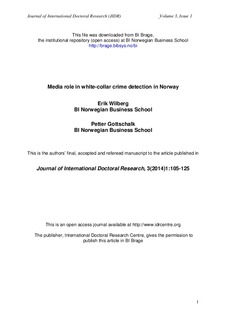| dc.contributor.author | Wilberg, Erik | |
| dc.contributor.author | Gottschalk, Petter | |
| dc.date.accessioned | 2015-02-04T10:08:20Z | |
| dc.date.available | 2015-02-04T10:08:20Z | |
| dc.date.issued | 2014 | |
| dc.identifier.citation | Journal of International Doctoral Research, 3(2014)1:105-125 | nb_NO |
| dc.identifier.issn | 2328-0832 | |
| dc.identifier.uri | http://hdl.handle.net/11250/275348 | |
| dc.description | This is an open access journal available at www.idrcentre.org | nb_NO |
| dc.description.abstract | In an empirical study of white-collar criminals in Norway, 80 out of 305 convicted criminals were detected by the media. This paper presents results from the study, and discusses media role in white-collar crime detection. White-collar crime detection and follow up seems to be related to a number of simultaneous journalistic procedures and cultural elements. For example, the argument of white-collar crime detection among journalists seems to be related to the story’s importance in itself and, as such, it will be treated as just another crime or news story and have the same internal process. It is also based on the elements of the story in itself and the extent that it can be described as a story that is regarded as interesting for the readers. That will be dependent on the general profile of the news medium, the journalistic competences and the overall resources and priorities of the news medium | nb_NO |
| dc.language.iso | eng | nb_NO |
| dc.publisher | International Doctoral Reseach Centre | nb_NO |
| dc.title | Media role in white-collar crime detection in Norway | nb_NO |
| dc.type | Journal article | nb_NO |
| dc.type | Peer reviewed | nb_NO |
| dc.source.journal | Journal of International Doctoral Research | nb_NO |
| dc.description.localcode | 1, Forfatterversjon | nb_NO |
